MaryAnn Bernal's Blog, page 220
November 11, 2014
Ice Age Death Rituals Revealed at Infant Burial Site
by Laura Geggel
[image error]
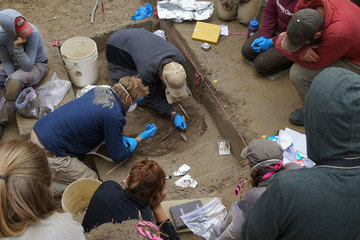
The excavation of a double infant burial dated to the last ice age, at the Upward Sun River site in Alaska.
Credit: Credit: Ben Potter | University of Alaska, Fairbanks
The fragile skeletons of two infants, discovered beneath the cremated remains of a 3-year-old child, may help researchers understand death rituals practiced during the last ice age in North America, a new study finds.
The children's remains, which date back to 11,500 years ago, were found in a hearth at Upward Sun River, an archaeological site in central Alaska. Researchers uncovered the cremated skeleton of the 3-year-old child in 2010, and returned to the site in 2013, digging deeper to see what else lay within the prehistoric hearth.
About 15.7 inches (40 centimeters) beneath the first cremated child, they found the double burial. [See a time-lapse video of the Alaskan excavation]
"When we got to the bottom [of the hearth], we identified a carpet of red ochre. That clearly set it out," said Ben Potter, an associate professor and chairman of anthropology at the University of Alaska, Fairbanks. "Then, we encountered the human remains and the grave goods at the very bottom. That was very unexpected and amazing."
The team immediately stopped the excavation, and contacted local and regional native groups and state officials, asking for permission to study the remains of the tiny infants.
"They were treating the human remains with respect, and that's really what you need to do," said Roy Carlson, professor emeritus of archaeology at Simon Fraser University in British Columbia, Canada, who was not involved in the study.
The skeletal remains of the two infants, found with their legs bent toward their chests, are a "remarkable and unusual" find, Carlson said. An analysis of the infants' teeth and bones suggests that one was likely a late-term fetus, and the other was about five weeks old, making them the youngest known individuals from the late Pleistocene epoch to receive burial treatment, the researchers wrote in the study.
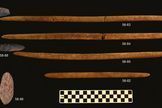
[image error] Researchers found stone darts or spears, and foreshafts made out of carved antlers in the prehistoric grave.
Credit: Ben Potter | University of Alaska, Fairbanks
The grave also holds a prehistoric hunting tool kit. The team found several stone-made bifaces, dart or spear points, and antler foreshafts decorated with geometric incisions next to the infants. Other ice-age findings have suggested that early hunters may have used stone weapons and foreshafts together, but the new finding is the first to provide concrete evidence that they were used in tandem.
"They were placed in the position that we could infer that they were attached," Potter told Live Science. "Imagine if you are a hunter on the landscape. You wouldn't want to carry a large amount of heavy spears or dart shafts with you. You would just have one or two [foreshafts], but you would have many points in case you break one."
The burial placement of the hunting tools suggests that terrestrial hunting, as opposed to fishing rods or other hunting weapons, were of utmost importance to the ice-age people, Potter said.
Twin clues
The relationship between the two infants, likely girls, remains a mystery. It's possible that the girls are twins, Potter said, but a DNA test would be needed to verify the idea.
It's unlikely that a highly mobile foraging society would have two deaths from different mothers at exactly the same time, he said. If they were twins, it might explain why the girls are buried together, he said.
"One could have died in utero, and then that enhances the potential for an early death for the surviving child," Potter said. [8 Grisly Archaeological Discoveries]
The soil at the burial site isn't that disturbed, so the infants may have been buried at the same time, the researchers said. Or, they could have died within a season or two of each other, which could indicate that they are not twins, Potter said.
Either way, researchers are looking forward to the results of the genetic tests. And regardless of whether the infants were twins, the people who buried the children clearly gave them deferential treatment.
"You have grave goods, ochre, burial in a highly flexed orientation, and the grave goods are quite amazing," Potter said. "For the upper [3-year-old] child, you do not have grave goods, you do not have ochre and the child is cremated. So this is quite interesting."
The team also found bones of ground squirrels and salmonids, which are fish related to present-day salmon, in the hearth. These animal bones suggest that the infants' burials took place during the summer, when these animals are typically in the region, Potter said.
Carlson said the findings are the result of "top-notch research."
"It brings forward information about Alaska 11,500 years ago from a time which we knew very little about and we know a lot more about now," he said.
The study was published online today (Nov. 10) in the journal the Proceedings of the National Academy of Sciences.
Live Science
[image error]

The excavation of a double infant burial dated to the last ice age, at the Upward Sun River site in Alaska.
Credit: Credit: Ben Potter | University of Alaska, Fairbanks
The fragile skeletons of two infants, discovered beneath the cremated remains of a 3-year-old child, may help researchers understand death rituals practiced during the last ice age in North America, a new study finds.
The children's remains, which date back to 11,500 years ago, were found in a hearth at Upward Sun River, an archaeological site in central Alaska. Researchers uncovered the cremated skeleton of the 3-year-old child in 2010, and returned to the site in 2013, digging deeper to see what else lay within the prehistoric hearth.
About 15.7 inches (40 centimeters) beneath the first cremated child, they found the double burial. [See a time-lapse video of the Alaskan excavation]
"When we got to the bottom [of the hearth], we identified a carpet of red ochre. That clearly set it out," said Ben Potter, an associate professor and chairman of anthropology at the University of Alaska, Fairbanks. "Then, we encountered the human remains and the grave goods at the very bottom. That was very unexpected and amazing."
The team immediately stopped the excavation, and contacted local and regional native groups and state officials, asking for permission to study the remains of the tiny infants.
"They were treating the human remains with respect, and that's really what you need to do," said Roy Carlson, professor emeritus of archaeology at Simon Fraser University in British Columbia, Canada, who was not involved in the study.
The skeletal remains of the two infants, found with their legs bent toward their chests, are a "remarkable and unusual" find, Carlson said. An analysis of the infants' teeth and bones suggests that one was likely a late-term fetus, and the other was about five weeks old, making them the youngest known individuals from the late Pleistocene epoch to receive burial treatment, the researchers wrote in the study.

[image error] Researchers found stone darts or spears, and foreshafts made out of carved antlers in the prehistoric grave.
Credit: Ben Potter | University of Alaska, Fairbanks
The grave also holds a prehistoric hunting tool kit. The team found several stone-made bifaces, dart or spear points, and antler foreshafts decorated with geometric incisions next to the infants. Other ice-age findings have suggested that early hunters may have used stone weapons and foreshafts together, but the new finding is the first to provide concrete evidence that they were used in tandem.
"They were placed in the position that we could infer that they were attached," Potter told Live Science. "Imagine if you are a hunter on the landscape. You wouldn't want to carry a large amount of heavy spears or dart shafts with you. You would just have one or two [foreshafts], but you would have many points in case you break one."
The burial placement of the hunting tools suggests that terrestrial hunting, as opposed to fishing rods or other hunting weapons, were of utmost importance to the ice-age people, Potter said.
Twin clues
The relationship between the two infants, likely girls, remains a mystery. It's possible that the girls are twins, Potter said, but a DNA test would be needed to verify the idea.
It's unlikely that a highly mobile foraging society would have two deaths from different mothers at exactly the same time, he said. If they were twins, it might explain why the girls are buried together, he said.
"One could have died in utero, and then that enhances the potential for an early death for the surviving child," Potter said. [8 Grisly Archaeological Discoveries]
The soil at the burial site isn't that disturbed, so the infants may have been buried at the same time, the researchers said. Or, they could have died within a season or two of each other, which could indicate that they are not twins, Potter said.
Either way, researchers are looking forward to the results of the genetic tests. And regardless of whether the infants were twins, the people who buried the children clearly gave them deferential treatment.
"You have grave goods, ochre, burial in a highly flexed orientation, and the grave goods are quite amazing," Potter said. "For the upper [3-year-old] child, you do not have grave goods, you do not have ochre and the child is cremated. So this is quite interesting."
The team also found bones of ground squirrels and salmonids, which are fish related to present-day salmon, in the hearth. These animal bones suggest that the infants' burials took place during the summer, when these animals are typically in the region, Potter said.
Carlson said the findings are the result of "top-notch research."
"It brings forward information about Alaska 11,500 years ago from a time which we knew very little about and we know a lot more about now," he said.
The study was published online today (Nov. 10) in the journal the Proceedings of the National Academy of Sciences.
Live Science

Published on November 11, 2014 14:57
350-Year-Old High Heels, Tea and Goblets Uncovered at Irish Castle
by Laura Geggel
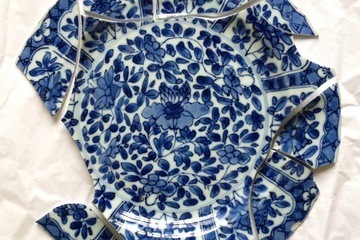
The archaeologists found several porcelain plates and teacups imported from China in the washing pit, including this blue-and-white plate. The plate, though broken, has visible seventeenth-century Qim Xi dynasty markings on the back.
Credit: Alva Mac Gowan
During a survey of an Irish castle, archaeologist Antoine Giacometti stuck his hand into a wet washing pit beneath the floor. He didn't expect to find anything in the pit, much less a golden piece of jewelry dating back to the late 1600s.
"I put my hand down into this wet, mucky thing, and there was a gold piece of jewelry with a possible gemstone in it," said Giacometti, the archaeological director of Archaeology Plan, an organization that preserves Ireland's archaeological heritage. "Then we realized that [the pit] was full of choc-a-bloc."
The pit at Rathfarnham Castle contained artifacts dating from 1650 to 1700, including pointy high-heeled women's shoes, porcelain plates and teacups imported from China. A Cromwellian armor breastplate and a jar of red material likely used to redden women's lips and cheeks were also found. [Dozens of families have lived in Rathfarnham Castle since its construction in 1583 in south Dublin. The waterlogged washing pit was likely sealed in about 1700, preserving the bric-a-brac, which even include tea leaves, Giacometti told Live Science.
Perhaps the castle's residents hid the items there during a raid, or maybe the knickknacks were placed there for washing and were never reclaimed. Or, a person could have dumped them into the pit, for lack of a better storage place, Giacometti said.
At any rate, the artifacts likely belonged to the household of Lord Adam Loftus (1625-1691), a descendant of the original Archbishop Adam Loftus, who built the castle, Giacometti said. The lord worked with King Charles II and King William of Orange, and oversaw Irish state finances during a time of great tension between Catholic Ireland and Protestant England.
Loftus lived at the castle with his wife Lucy, son James, who died young, and daughter Lucia, who married Philip Wharton the infamous "Rake of Rathfarnham." The rake, a notorious rascal, scammed his way into prestigious positions, married multiple times (typically with bad results), invested heavily in economic bubbles and died nearly penniless, Giacometti said.
The rake lived in the early 1700s, unfortunately too late for the artifacts to belong to him, Giacometti said. "He was shocking. He was famous for having loads of mistresses and getting really drunk at parties and then removing his clothing."
The rake died at age 32, likely from syphilis, Giacometti said.
Unexpected finding
Earlier this year, conservation builders and archaeologists began fixing up Rathfarnham Castle, which has been designated a national monument. The castle, which will soon have elevators and improved access, has a storied past. Queen Elizabeth I tasked Archbishop Adam Loftus, who lived there during the late 1500s, with spreading Protestantism to Ireland. The archbishop had many enemies, which likely prompted him to build gun loops — small round holes in the walls — for musket fire, which pointed toward the two entrances of the castle.
Other Irish castles at that time had arrow loops for bows and arrows, Giacometti said.
"Our castle was constructed for somebody who had access to the latest weapons," he said. "This is a Renaissance building for somebody very special." [10 Epic Battles that Changed History]
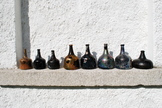
[image error] These glass wine and spirit bottles found at Rathfarnham Castle were likely made in the 1650s.
These glass wine and spirit bottles found at Rathfarnham Castle were likely made in the 1650s.
Credit: Alva Mac Gowan | Archaeology Plan
View full size imageDespite the political turbulence, the castle's inhabitants lived rich and lavish lives, Giacometti said. His team found medieval toilets, called garderobes, 16th century fireplaces framed in yellow sandstone in the castle's upper floors and two massive kitchen fireplaces that were originally thought to be cupboards.
The cache of artifacts uncovered in the washing pit reveal the Loftus family's connections to a world awash in the latest fashions. Tea came to England in the mid-1600s, and it's impressive that a family in Ireland had access to the contemporary trend, Giacometti said.
"Ireland has always been viewed as the poor neighbor," he said. "We were behind the times, still kind of living with the trees when the British were colonizing the world. [The tea] kind of puts Ireland on the map a bit."
Hidden treasures
The archaeologists also found a jar filled with a red substance, likely an imported product containing the pigment of the bright red Central American cochineal insect, which is still used as coloring today.
"In 17th century portraits, they all have rosy cheeks," Giacometti said. "We have an ointment jar of this stuff."
A breastplate damaged by a musket provides more evidence of the region's political instability in the late 1600s. As legend has it, men fighting for Oliver Cromwell against Ireland's Roman Catholics lodged at the castle in the 1660s or 1670s, Giacometti said.
"There's a document that they ordered a set of breastplates from London, which are the exact same breastplates we have," he said.
The archeologists also found shoes — pointy high-heeled ones for women and square-tipped shoes for men decorated with buckles and ribbons. "The shoes are really interesting because they didn't have right shoes or left shoes," Giacometti said. "They used to get them in batches of six or seven and swap them."
Members of the public can visit Rathfarnham Castle to see its 18th century plasterwork and sip refreshments in the castle's tearooms, but those interested in seeing the newfound artifacts will likely have to wait until 2017 at the earliest, Giacometti said.
"Conserving the leather shoes is going to take a huge amount of time," he said.See photos of the treasures found at Rathfarnham Castle]
Live Science


The archaeologists found several porcelain plates and teacups imported from China in the washing pit, including this blue-and-white plate. The plate, though broken, has visible seventeenth-century Qim Xi dynasty markings on the back.
Credit: Alva Mac Gowan
During a survey of an Irish castle, archaeologist Antoine Giacometti stuck his hand into a wet washing pit beneath the floor. He didn't expect to find anything in the pit, much less a golden piece of jewelry dating back to the late 1600s.
"I put my hand down into this wet, mucky thing, and there was a gold piece of jewelry with a possible gemstone in it," said Giacometti, the archaeological director of Archaeology Plan, an organization that preserves Ireland's archaeological heritage. "Then we realized that [the pit] was full of choc-a-bloc."
The pit at Rathfarnham Castle contained artifacts dating from 1650 to 1700, including pointy high-heeled women's shoes, porcelain plates and teacups imported from China. A Cromwellian armor breastplate and a jar of red material likely used to redden women's lips and cheeks were also found. [Dozens of families have lived in Rathfarnham Castle since its construction in 1583 in south Dublin. The waterlogged washing pit was likely sealed in about 1700, preserving the bric-a-brac, which even include tea leaves, Giacometti told Live Science.
Perhaps the castle's residents hid the items there during a raid, or maybe the knickknacks were placed there for washing and were never reclaimed. Or, a person could have dumped them into the pit, for lack of a better storage place, Giacometti said.
At any rate, the artifacts likely belonged to the household of Lord Adam Loftus (1625-1691), a descendant of the original Archbishop Adam Loftus, who built the castle, Giacometti said. The lord worked with King Charles II and King William of Orange, and oversaw Irish state finances during a time of great tension between Catholic Ireland and Protestant England.
Loftus lived at the castle with his wife Lucy, son James, who died young, and daughter Lucia, who married Philip Wharton the infamous "Rake of Rathfarnham." The rake, a notorious rascal, scammed his way into prestigious positions, married multiple times (typically with bad results), invested heavily in economic bubbles and died nearly penniless, Giacometti said.
The rake lived in the early 1700s, unfortunately too late for the artifacts to belong to him, Giacometti said. "He was shocking. He was famous for having loads of mistresses and getting really drunk at parties and then removing his clothing."
The rake died at age 32, likely from syphilis, Giacometti said.
Unexpected finding
Earlier this year, conservation builders and archaeologists began fixing up Rathfarnham Castle, which has been designated a national monument. The castle, which will soon have elevators and improved access, has a storied past. Queen Elizabeth I tasked Archbishop Adam Loftus, who lived there during the late 1500s, with spreading Protestantism to Ireland. The archbishop had many enemies, which likely prompted him to build gun loops — small round holes in the walls — for musket fire, which pointed toward the two entrances of the castle.
Other Irish castles at that time had arrow loops for bows and arrows, Giacometti said.
"Our castle was constructed for somebody who had access to the latest weapons," he said. "This is a Renaissance building for somebody very special." [10 Epic Battles that Changed History]

[image error]
 These glass wine and spirit bottles found at Rathfarnham Castle were likely made in the 1650s.
These glass wine and spirit bottles found at Rathfarnham Castle were likely made in the 1650s.Credit: Alva Mac Gowan | Archaeology Plan
View full size imageDespite the political turbulence, the castle's inhabitants lived rich and lavish lives, Giacometti said. His team found medieval toilets, called garderobes, 16th century fireplaces framed in yellow sandstone in the castle's upper floors and two massive kitchen fireplaces that were originally thought to be cupboards.
The cache of artifacts uncovered in the washing pit reveal the Loftus family's connections to a world awash in the latest fashions. Tea came to England in the mid-1600s, and it's impressive that a family in Ireland had access to the contemporary trend, Giacometti said.
"Ireland has always been viewed as the poor neighbor," he said. "We were behind the times, still kind of living with the trees when the British were colonizing the world. [The tea] kind of puts Ireland on the map a bit."
Hidden treasures
The archaeologists also found a jar filled with a red substance, likely an imported product containing the pigment of the bright red Central American cochineal insect, which is still used as coloring today.
"In 17th century portraits, they all have rosy cheeks," Giacometti said. "We have an ointment jar of this stuff."
A breastplate damaged by a musket provides more evidence of the region's political instability in the late 1600s. As legend has it, men fighting for Oliver Cromwell against Ireland's Roman Catholics lodged at the castle in the 1660s or 1670s, Giacometti said.
"There's a document that they ordered a set of breastplates from London, which are the exact same breastplates we have," he said.
The archeologists also found shoes — pointy high-heeled ones for women and square-tipped shoes for men decorated with buckles and ribbons. "The shoes are really interesting because they didn't have right shoes or left shoes," Giacometti said. "They used to get them in batches of six or seven and swap them."
Members of the public can visit Rathfarnham Castle to see its 18th century plasterwork and sip refreshments in the castle's tearooms, but those interested in seeing the newfound artifacts will likely have to wait until 2017 at the earliest, Giacometti said.
"Conserving the leather shoes is going to take a huge amount of time," he said.See photos of the treasures found at Rathfarnham Castle]
Live Science

Published on November 11, 2014 14:48
The Epic of Gilgamesh presented by Sebastian Lockwood at the Fitzwilliam Town Library - Wed. Nov. 12, 2014 7pm
Fitzwilliam Town Library
2009 NH Library of the Year
Come hear the oldest tale of all. Two hearts together can overcome anything!
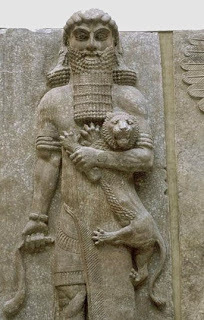 Gilgamesh is the great epic of ancient Mesopotamia, one of the oldest works in western literature, contemporary with the oldest parts of the Bible. It is the story of a legendary king who achieves heroic victories with the help of the wild man Enkidu. The Gilgamesh epic, written over four thousand years ago in ancient cuneiform script, was found on broken tablets in what is today Iraq * where the cradle of civilization is believed to have developed between the Tigris and the Euphrates rivers.Sebastian Lockwood brings the story of Gilgamesh and Enkidu to life as these two discover each other, leave on a great adventure to battle the monstrous giant Huwawa, where they will face Ishtar and death, and travel to see Utnapishtin (Noah) to find the answer to why we die.
Gilgamesh is the great epic of ancient Mesopotamia, one of the oldest works in western literature, contemporary with the oldest parts of the Bible. It is the story of a legendary king who achieves heroic victories with the help of the wild man Enkidu. The Gilgamesh epic, written over four thousand years ago in ancient cuneiform script, was found on broken tablets in what is today Iraq * where the cradle of civilization is believed to have developed between the Tigris and the Euphrates rivers.Sebastian Lockwood brings the story of Gilgamesh and Enkidu to life as these two discover each other, leave on a great adventure to battle the monstrous giant Huwawa, where they will face Ishtar and death, and travel to see Utnapishtin (Noah) to find the answer to why we die.
Sebastian Lockwood is a poet, teacher, and storyteller who specializes in the epics: The Epic of Gilgamesh, Homer*s Odyssey, and Beowulf. He studied the classics and anthropology at Boston University and the UK*s Cambridge University. Currently, Lockwood performs far and wide, as well as teaches at several universities the techniques of storytelling and the use of poetry for artists and teachers.
Location:
Location11 Templeton Turnpike
Fitzwilliam, NH
We are on the town common, right next to the Town Hall.
[image error]
Purchase on audible

2009 NH Library of the Year
Come hear the oldest tale of all. Two hearts together can overcome anything!
 Gilgamesh is the great epic of ancient Mesopotamia, one of the oldest works in western literature, contemporary with the oldest parts of the Bible. It is the story of a legendary king who achieves heroic victories with the help of the wild man Enkidu. The Gilgamesh epic, written over four thousand years ago in ancient cuneiform script, was found on broken tablets in what is today Iraq * where the cradle of civilization is believed to have developed between the Tigris and the Euphrates rivers.Sebastian Lockwood brings the story of Gilgamesh and Enkidu to life as these two discover each other, leave on a great adventure to battle the monstrous giant Huwawa, where they will face Ishtar and death, and travel to see Utnapishtin (Noah) to find the answer to why we die.
Gilgamesh is the great epic of ancient Mesopotamia, one of the oldest works in western literature, contemporary with the oldest parts of the Bible. It is the story of a legendary king who achieves heroic victories with the help of the wild man Enkidu. The Gilgamesh epic, written over four thousand years ago in ancient cuneiform script, was found on broken tablets in what is today Iraq * where the cradle of civilization is believed to have developed between the Tigris and the Euphrates rivers.Sebastian Lockwood brings the story of Gilgamesh and Enkidu to life as these two discover each other, leave on a great adventure to battle the monstrous giant Huwawa, where they will face Ishtar and death, and travel to see Utnapishtin (Noah) to find the answer to why we die. Sebastian Lockwood is a poet, teacher, and storyteller who specializes in the epics: The Epic of Gilgamesh, Homer*s Odyssey, and Beowulf. He studied the classics and anthropology at Boston University and the UK*s Cambridge University. Currently, Lockwood performs far and wide, as well as teaches at several universities the techniques of storytelling and the use of poetry for artists and teachers.
Location:
Location11 Templeton Turnpike
Fitzwilliam, NH
We are on the town common, right next to the Town Hall.
[image error]
Purchase on audible

Published on November 11, 2014 07:33
Veterans Day - November 11
 National Veterans Day CeremonyThe Veterans Day National Ceremony is held each year on November 11th at Arlington National Cemetery . The ceremony commences precisely at 11:00 a.m. with a wreath laying at the Tomb of the Unknowns and continues inside the Memorial Amphitheater with a parade of colors by veterans' organizations and remarks from dignitaries. The ceremony is intended to honor and thank all who served in the United States Armed Forces.
National Veterans Day CeremonyThe Veterans Day National Ceremony is held each year on November 11th at Arlington National Cemetery . The ceremony commences precisely at 11:00 a.m. with a wreath laying at the Tomb of the Unknowns and continues inside the Memorial Amphitheater with a parade of colors by veterans' organizations and remarks from dignitaries. The ceremony is intended to honor and thank all who served in the United States Armed Forces.History of Veterans DayWorld War I – known at the time as “The Great War” - officially ended when the Treaty of Versailles was signed on June 28, 1919, in the Palace of Versailles outside the town of Versailles, France. However, fighting ceased seven months earlier when an armistice, or temporary cessation of hostilities, between the Allied nations and Germany went into effect on the eleventh hour of the eleventh day of the eleventh month. For that reason, November 11, 1918, is generally regarded as the end of “the war to end all wars.”
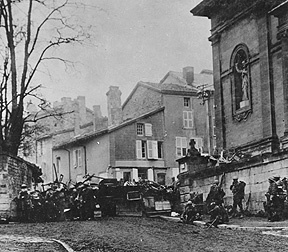 Soldiers of the 353rd Infantry near a church at Stenay, Meuse in France, wait for the end of hostilities. This photo was taken at 10:58 a.m., on November 11, 1918, two minutes before the armistice ending World War I went into effectIn November 1919, President Wilson proclaimed November 11 as the first commemoration of Armistice Day with the following words: "To us in America, the reflections of Armistice Day will be filled with solemn pride in the heroism of those who died in the country’s service and with gratitude for the victory, both because of the thing from which it has freed us and because of the opportunity it has given America to show her sympathy with peace and justice in the councils of the nations…"
Soldiers of the 353rd Infantry near a church at Stenay, Meuse in France, wait for the end of hostilities. This photo was taken at 10:58 a.m., on November 11, 1918, two minutes before the armistice ending World War I went into effectIn November 1919, President Wilson proclaimed November 11 as the first commemoration of Armistice Day with the following words: "To us in America, the reflections of Armistice Day will be filled with solemn pride in the heroism of those who died in the country’s service and with gratitude for the victory, both because of the thing from which it has freed us and because of the opportunity it has given America to show her sympathy with peace and justice in the councils of the nations…"The original concept for the celebration was for a day observed with parades and public meetings and a brief suspension of business beginning at 11:00 a.m.
The United States Congress officially recognized the end of World War I when it passed a concurrent resolution on June 4, 1926, with these words:
Whereas the 11th of November 1918, marked the cessation of the most destructive, sanguinary, and far reaching war in human annals and the resumption by the people of the United States of peaceful relations with other nations, which we hope may never again be severed, andAn Act (52 Stat. 351; 5 U. S. Code, Sec. 87a) approved May 13, 1938, made the 11th of November in each year a legal holiday—a day to be dedicated to the cause of world peace and to be thereafter celebrated and known as "Armistice Day." Armistice Day was primarily a day set aside to honor veterans of World War I, but in 1954, after World War II had required the greatest mobilization of soldiers, sailors, Marines and airmen in the Nation’s history; after American forces had fought aggression in Korea, the 83rd Congress, at the urging of the veterans service organizations, amended the Act of 1938 by striking out the word "Armistice" and inserting in its place the word "Veterans." With the approval of this legislation (Public Law 380) on June 1, 1954, November 11th became a day to honor American veterans of all wars.
Whereas it is fitting that the recurring anniversary of this date should be commemorated with thanksgiving and prayer and exercises designed to perpetuate peace through good will and mutual understanding between nations; and
Whereas the legislatures of twenty-seven of our States have already declared November 11 to be a legal holiday: Therefore be it Resolved by the Senate (the House of Representatives concurring), that the President of the United States is requested to issue a proclamation calling upon the officials to display the flag of the United States on all Government buildings on November 11 and inviting the people of the United States to observe the day in schools and churches, or other suitable places, with appropriate ceremonies of friendly relations with all other peoples.
Later that same year, on October 8th, President Dwight D. Eisenhower issued the first "Veterans Day Proclamation" which stated: "In order to insure proper and widespread observance of this anniversary, all veterans, all veterans' organizations, and the entire citizenry will wish to join hands in the common purpose. Toward this end, I am designating the Administrator of Veterans' Affairs as Chairman of a Veterans Day National Committee, which shall include such other persons as the Chairman may select, and which will coordinate at the national level necessary planning for the observance. I am also requesting the heads of all departments and agencies of the Executive branch of the Government to assist the National Committee in every way possible."
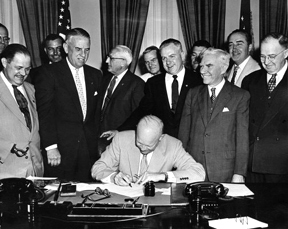 President Eisenhower signing HR7786, changing Armistice Day to Veterans Day. From left: Alvin J. King, Wayne Richards, Arthur J. Connell, John T. Nation, Edward Rees, Richard L. Trombla, Howard W. Watts On that same day, President Eisenhower sent a letter to the Honorable Harvey V. Higley, Administrator of Veterans' Affairs (VA), designating him as Chairman of the Veterans Day National Committee.
President Eisenhower signing HR7786, changing Armistice Day to Veterans Day. From left: Alvin J. King, Wayne Richards, Arthur J. Connell, John T. Nation, Edward Rees, Richard L. Trombla, Howard W. Watts On that same day, President Eisenhower sent a letter to the Honorable Harvey V. Higley, Administrator of Veterans' Affairs (VA), designating him as Chairman of the Veterans Day National Committee.In 1958, the White House advised VA's General Counsel that the 1954 designation of the VA Administrator as Chairman of the Veterans Day National Committee applied to all subsequent VA Administrators. Since March 1989 when VA was elevated to a cabinet level department, the Secretary of Veterans Affairs has served as the committee's chairman.
The Uniform Holiday Bill (Public Law 90-363 (82 Stat. 250)) was signed on June 28, 1968, and was intended to ensure three-day weekends for Federal employees by celebrating four national holidays on Mondays: Washington's Birthday, Memorial Day, Veterans Day, and Columbus Day. It was thought that these extended weekends would encourage travel, recreational and cultural activities and stimulate greater industrial and commercial production. Many states did not agree with this decision and continued to celebrate the holidays on their original dates.
The first Veterans Day under the new law was observed with much confusion on October 25, 1971. It was quite apparent that the commemoration of this day was a matter of historic and patriotic significance to a great number of our citizens, and so on September 20th, 1975, President Gerald R. Ford signed Public Law 94-97 (89 Stat. 479), which returned the annual observance of Veterans Day to its original date of November 11, beginning in 1978. This action supported the desires of the overwhelming majority of state legislatures, all major veterans service organizations and the American people.
Veterans Day continues to be observed on November 11, regardless of what day of the week on which it falls. The restoration of the observance of Veterans Day to November 11 not only preserves the historical significance of the date, but helps focus attention on the important purpose of Veterans Day: A celebration to honor America's veterans for their patriotism, love of country, and willingness to serve and sacrifice for the common good.
US Dept of Veteran Affairs

Published on November 11, 2014 04:18
History Trivia - The Fourth Lateran Council meets
November 11
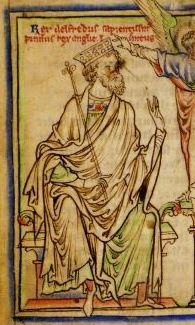
887 Asser began Instructing King Alfred. The Welsh monk who taught and counseled the King, became his friend and biographer, and began teaching him Latin on St. Martin's Day. Alfred went on to translate the work of Boethius into English.
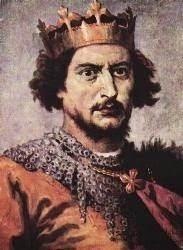
1050 AD Henry IV was born. He was King of Germany 1056-1106, who tried to depose Pope Gregory VII, and had to stand barefoot in the snow for three days before Gregory would pardon him, although Henry got his revenge later.
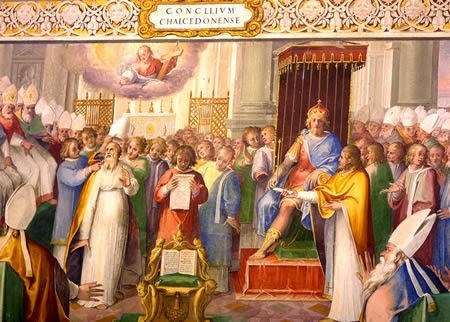
1215 The Fourth Lateran Council met and defined the doctrine of transubstantiation, the process by which bread and wine are transformed into the body and blood of Christ.

1417 Martin V Elected Pope. Elected unanimously during the Council of Constance, Martin was faced with the enormous task of restoring the Western church, the Papal States, and the papacy itself.

1572 Tycho's Nova. Danish astronomer Tycho Brahe observed the Nova Cassiopeiae and, although other observers claimed to have spotted it earlier, his precise measurements revealed it was a distant phenomenon and that changes could occur among stars.


887 Asser began Instructing King Alfred. The Welsh monk who taught and counseled the King, became his friend and biographer, and began teaching him Latin on St. Martin's Day. Alfred went on to translate the work of Boethius into English.

1050 AD Henry IV was born. He was King of Germany 1056-1106, who tried to depose Pope Gregory VII, and had to stand barefoot in the snow for three days before Gregory would pardon him, although Henry got his revenge later.

1215 The Fourth Lateran Council met and defined the doctrine of transubstantiation, the process by which bread and wine are transformed into the body and blood of Christ.

1417 Martin V Elected Pope. Elected unanimously during the Council of Constance, Martin was faced with the enormous task of restoring the Western church, the Papal States, and the papacy itself.

1572 Tycho's Nova. Danish astronomer Tycho Brahe observed the Nova Cassiopeiae and, although other observers claimed to have spotted it earlier, his precise measurements revealed it was a distant phenomenon and that changes could occur among stars.

Published on November 11, 2014 04:15
November 10, 2014
Magna Carta Goes on Display in Washington, D.C.

The Lincoln Cathedral Magna Carta, signed by King John in 2015.by Megan Gannon
Scrawled in Medieval Latin on yellowing parchment, an original copy of the Magna Carta is now on view at the Library of Congress in Washington, D.C.
The historic charter turns 800 next year. To celebrate, the Library of Congress is hosting a 10-week exhibition, "Magna Carta: Muse and Mentor."
The centerpiece of the show is the Lincoln Cathedral Magna Carta, on loan from its caretaker, the Lincoln Cathedral in England. [See photos of the Magna Carta texts on display]
The document is one of just four surviving copies from 1215. That year, English barons pressured King John (who was later villainized in the legend of Robin Hood) into signing the Magna Carta. The text had 63 clauses drawn up to limit John's power, but by far the most enduring article was this one:
"No free man shall be seized or imprisoned, or stripped of his rights or possessions, or outlawed or exiled … except by the lawful judgment of his equals or by the law of the land."
The clause protected free men in England from being unlawfully imprisoned, and that article became the basis for the writ of habeas corpus in the 17th century, when interest in the Magna Carta as an affirmation of individual liberties was revived. Habeas corpus is still invoked today to bring a prisoner before a court to determine if that person's imprisonment is legal, and it's considered one of the most important privileges associated with English civil liberties.
The concept has spread to many other judicial systems. It was reflected in the laws established in the North American colonies, and the framers of the U.S. Constitution later derived the clauses about grand juries and due process in the Fifth Amendment from that part of the Magna Carta.
This exhibition is not the first U.S. tour for the Lincoln Cathedral Magna Carta. The text went on display at the British Pavilion at the 1939 New York World's Fair. By the fall of that year, World War II started with the German invasion of Poland. The copy of the Magna Carta traveled to Washington, D.C., where the British Ambassador to the United States handed it over to the Library of Congress on Nov. 28, 1939. It was kept at Fort Knox in Kentucky for safekeeping during the war.
The "Magna Carta: Muse and Mentor" exhibit at the Library of Congress is on display until Jan. 19, 2015.
Live Science

Published on November 10, 2014 06:51
Happy 239th Birthday to The United States Marines

The Marines' HymnThe most recognizable military hymn and the oldest official song in the U.S. Armed Forces, The Marines' Hymn is a reminder of the sacrifice and courage that Marines have shown on the battlefield. It is an important part of Marine Corps culture—every Marine can recite its three stanzas by heart.
From the Halls of Montezuma,
To the shores of Tripoli;
We fight our country's battles
In the air, on land, and sea;
First to fight for right and freedom
And to keep our honor clean:
We are proud to claim the title
Of United States Marine.
Our flag's unfurled to every breeze
From dawn to setting sun;
We have fought in every clime and place
Where we could take a gun;
In the snow of far-off Northern lands
And in sunny tropic scenes;
You will find us always on the job
The United States Marines.
Here's health to you and to our Corps
Which we are proud to serve;
In many a strife we've fought for life
And never lost our nerve;
If the Army and the Navy
Ever look on Heaven's scenes;
They will find the streets are guarded
By The United States Marines.


Published on November 10, 2014 05:41
History Trivia - The Battle of Varna - Turkish victory
November 10
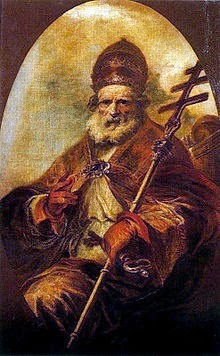
461 St Leo I ended his reign as Catholic Pope.

627 Saint Justus died. The fourth archbishop of Canterbury, Justus had a role in converting Northumbria to Christianity.
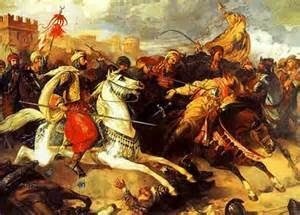
1444 The Battle of Varna: The Turkish victory over a Hungarian force ended the efforts of European powers to save Constantinople from Turkish conquest.

1619 René Descartes had the dreams that inspired his Meditations on First Philosophy.


461 St Leo I ended his reign as Catholic Pope.

627 Saint Justus died. The fourth archbishop of Canterbury, Justus had a role in converting Northumbria to Christianity.

1444 The Battle of Varna: The Turkish victory over a Hungarian force ended the efforts of European powers to save Constantinople from Turkish conquest.

1619 René Descartes had the dreams that inspired his Meditations on First Philosophy.

Published on November 10, 2014 05:33
November 9, 2014
History Trivia - Queen Catherine Howard confined in London Tower.
November 9

694 Egica, a King of the Visigoths of Hispania, accused the Jews of aiding Muslims, and sentenced all Jews to slavery.
 Perkin Warbeck
Perkin Warbeck
1492 Peace of Etaples (northern France) between Henry VII and Charles VIII. The treaty served to end an English invasion of France launched in order to stop France's support for the pretender Perkin Warbeck. By this treaty, France agreed to expel Warbeck and pay England an indemnity of £159,000. The treaty was ratified in December
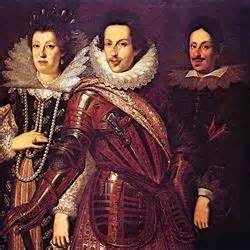
1494 The de' Medici family were expelled from Florence.

Traitor's Gate1541 Queen Catherine Howard was confined in London Tower.


694 Egica, a King of the Visigoths of Hispania, accused the Jews of aiding Muslims, and sentenced all Jews to slavery.
 Perkin Warbeck
Perkin Warbeck1492 Peace of Etaples (northern France) between Henry VII and Charles VIII. The treaty served to end an English invasion of France launched in order to stop France's support for the pretender Perkin Warbeck. By this treaty, France agreed to expel Warbeck and pay England an indemnity of £159,000. The treaty was ratified in December

1494 The de' Medici family were expelled from Florence.

Traitor's Gate1541 Queen Catherine Howard was confined in London Tower.

Published on November 09, 2014 04:34
November 8, 2014
History Trivia - Roman Emperor Theodosius prohibits all pagan worship in the empire
November 8
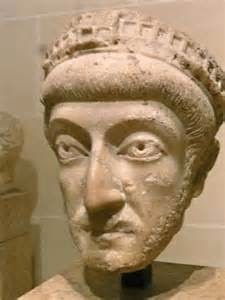
392 Roman Emperor Theodosius passed legislation prohibiting all pagan worship in the empire.
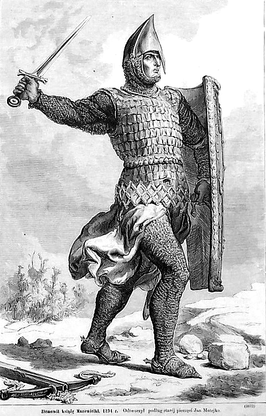
911 Duke Koenraad I was chosen German king.

1097 Anselm, Archbishop of Canterbury, went into exile after a breach with William II over papal supremacy.

1308 John Duns Scotus died. He was an influential Franciscan philosopher and theologian who pioneered the theory of the Immaculate Conception.
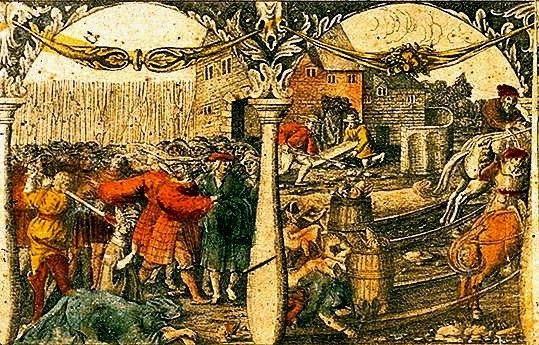
1520 Stockholm Bloodbath began: A successful invasion of Sweden by Danish forces resulted in the execution of around 100 people.


392 Roman Emperor Theodosius passed legislation prohibiting all pagan worship in the empire.

911 Duke Koenraad I was chosen German king.

1097 Anselm, Archbishop of Canterbury, went into exile after a breach with William II over papal supremacy.

1308 John Duns Scotus died. He was an influential Franciscan philosopher and theologian who pioneered the theory of the Immaculate Conception.

1520 Stockholm Bloodbath began: A successful invasion of Sweden by Danish forces resulted in the execution of around 100 people.

Published on November 08, 2014 05:22



